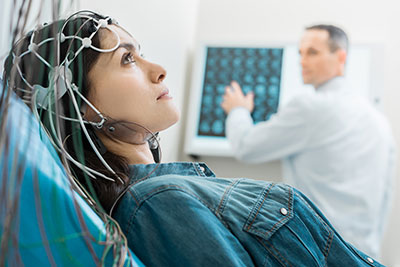QEEG Recordings Not Recommended for Determining Depression-Treatment Response
Abstract
A meta-analysis of 76 studies involving quantitative EEG to predict treatment response in patients with depression finds the method is not ready for routine clinical use.
Electroencephalography (EEG) is a procedure that produces wave-like readouts of electrical activity in the brain. With the advent of modern computing programs, these brain waves can be analyzed in greater detail, and some researchers believe this analysis—known as quantitative EEG (QEEG)—might identify signals that can help psychiatrists identify the right treatment for patients with depression.

A comprehensive analysis of QEEG studies published October 3 in AJP in Advance suggests that such claims about QEEG exceed the reality.
“Our findings indicate that QEEG, as studied and published to date, is not well supported as a predictive biomarker for treatment response in depression,” wrote Alik S. Widge, M.D., Ph.D., an assistant professor of psychiatry at the University of Minnesota, and colleagues.
The analysis is the latest from the APA Task Force for Novel Biomarkers and Treatments, a panel of clinical and research experts that has undertaken the task of critically reviewing the latest trends in psychiatric practice. The expert group recently completed a similar analysis on pharmacogenetic tests.
“Right now, psychiatry is staring at a lot of technical innovation that is also preceded by a lot of hype,” said Widge, a member of the APA task force. “It is important to get through all the promotion and commercialization to see if these advances actually work.”
It is easy to see the appeal of EEG as a diagnostic tool for depression care, he said. Unlike blood biomarkers or genetic polymorphisms, EEG directly measures brain activity. EEG tests are also cheaper and easier to administer than other tools that look at brain activity such as MRI or PET scans.
Numerous research studies, often led by companies that design EEG diagnostics, suggest that quantitative measurements such as the loudness dependence of auditory evoked potentials or theta wave oscillatory power can help psychiatrists identify the optimal depression treatment.
Widge and colleagues conducted a thorough review of 76 studies involving QEEG to predict treatment response in patients with depression. The studies, which were published between January 2000 and November 2017, explored a wide range of both QEEG biomarkers (81 in total) and treatments (various antidepressants were tested as well as transcranial magnetic stimulation and electrical brain stimulation).
Overall, QEEG-based biomarkers could identify if a patient would respond to a given treatment with about 76 percent accuracy. There were no significant differences between the specific biomarker that was used or in the treatment types (medication, TMS, other), which suggests the biomarkers are similarly reliable at predicting treatment response.
Widge told Psychiatric News that he suspects the 76 percent accuracy rating is likely an overestimate due to underreporting of negative results and insufficient external validation of positive findings from labs that developed the QEEG biomarkers examined.
In addition, he said, it can be difficult to broadly interpret the findings of these QEEG biomarker studies. He noted that while major depression is an incredibly heterogenous disorder, the QEEG studies lumped patients with depression into one category. “Some studies even grouped together patients with unipolar depression and bipolar depression,” he said.
Given all these factors, the members on the task force concluded that at this time the “[u]se of commercial or research-grade [EEG] methods in routine clinical practice would not be a wise use of health care dollars.”
Widge emphasized that these conclusions do not imply that there is no value in EEG research. “There is very real and serious science underlying these studies,” he said. “We have strong evidence that EEG captures important aspects on how the brain processes information. It just can’t tell you which pill to put in your mouth.”
This analysis was supported in part by grants from the Brain and Behavior Research Foundation, the Harvard Brain Science Initiative, and National Institute of Mental Health. ■



